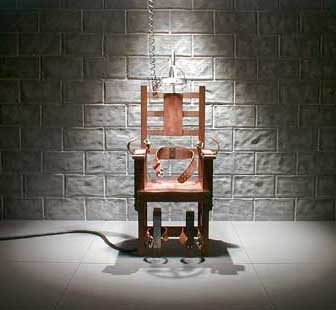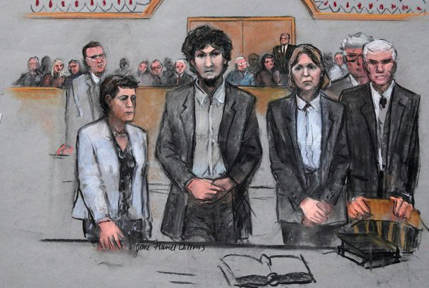In the 18th Century BC, the Code of King Hammurabi of Babylon codified the death penalty for twenty-five different crimes. In the 7th Century BC, Draco made it the only punishment for any crime. According to Plutarch, "Draco...being asked why he made death the penalty for most offences, replied that in his opinion the lesser ones deserved it, and for the greater ones no heavier penalty could be found."
In the twenty first century, the death penalty is a roiling pot of controversy. No more is stoning, scaphism, or even crushing by elephant a part of our lexicon. Instead, the green mile to the altar of death is lined with red tape.
As we struggle to delineate the upper limits of the United States justice system, ideas of human rights and financial concerns render the situation much more complex than ancient forms of punishment and torture. The trial and conviction of Dzhokhar Tsarnaev brings this conflict to the forefront.
Karen Brassard, one of Tsarnaev's victims in the Boston Marathon Bombings, acknowledged the fact that "all-but-certain appeals meant the case could drag out over years if not decades."
In CAREY DEAN MOORE v. NEBRASKA, Justice Breyer's dissenting opinion included the idea that "Our Constitution was written at a time when delay between sentencing and execution could be measured in days or weeks, not decades." English law in the 18th century called for executions to take place on "the next day but one" after sentencing. It is not unusual for many inmates on death row to die of natural causes, and even old age. As the gap between conviction and execution widens, we can expect to see even more of this.
These facts speak to one of the most blatant failings of our prison system. According to the US Department of Justice, in 2010, the average time between sentencing and execution was nearly 15 years for inmates on death row. The speed of a death sentence conviction is simply a wolf in sheep's clothing: the illusion of Tsarnaev's imminent death is just that. And beyond that, this dog and pony show has real, tangible ramifications for the taxpaying American public. In Washington, a study found that death penalty cases averaged $1 million more than similar cases where the death penalty was not sought. Defense costs were three times as high, and prosecution costs were four times higher. A study in California concluded that a repeal of the death penalty could save the state as much as $5 billion over the next 20 years. We the People are literally paying for the illusion of a harsher sentence.
Nonwithstanding the financial concerns of the penalty, Tsarnaev's death sentence represents an illusion for both the victims of the bombings and the public. While the sentence carries with it a tantalizing news byte for journalists, as of now, that's all it is. Rendered unequivocally guilty by the jury, Tsarnaev will now wind his way through the court system, draining American resources for years to come.


